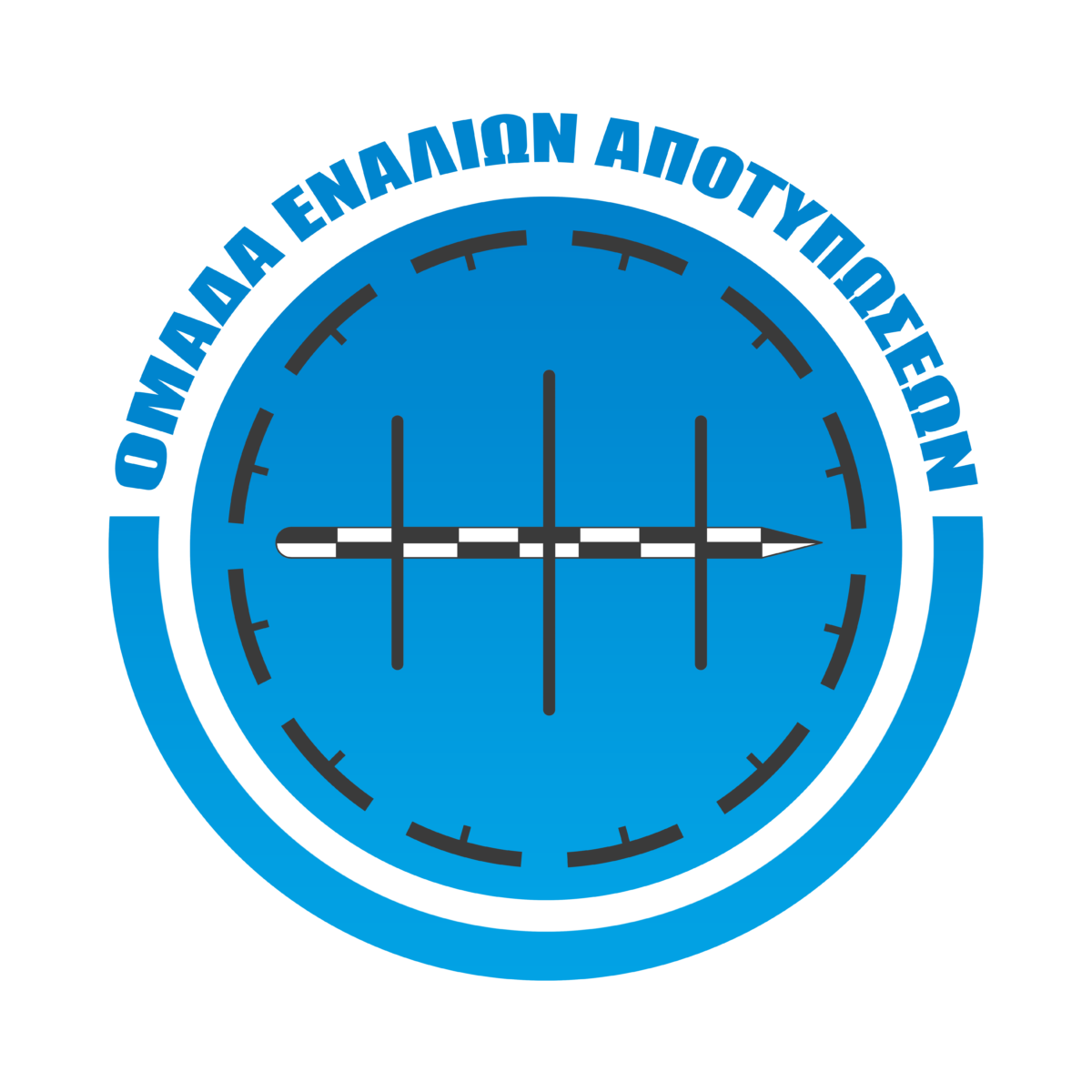The steamships ALFIOS, ACHELOOS, EUROTAS and PENIOS joined the Greek Fleet in 1885. The ALFIOS and ACHELOOS were delivered by the Thames Iron Works & Shipbuilding Co. in Blackwall, England, while the PENIOS and EUROS came from the Scottish yards of Archibald McMillan & Son in Dumbarton. In April 1934, the ACHELOS was renamed the AKTI when it became the property of I. Peppa and briefly used in a shipyard until it was scrapped. The EUROTAS was acquired by Achilleas Chalkousis in 1945 and later sank as the NAGOS on July 26, 1951 after taking in water. The PINEIUS was renamed the TRIS IERARCHE by Ach. Katzani & Co. and sank on January 13, 1959 due to bad weather. In May 1925, the ALFIOS was converted into an oceanographic vessel and renamed the NAUTILOS, it was decommissioned in 1936, and the following year it was converted into a barge. Details of its final fate remain unknown.
In 1884, the Greek government approved the funding of 1.6 million pounds from a loan it had received the previous year to acquire four armored warships with a displacement of 5,000 tons, as well as some smaller vessels. Eventually, instead of the armored warships, four smaller unarmored vessels were built in British yards, the steamships [1] ALFIOS, ACHELOS, EUROTAS and PENIOS, which were also called ‘the Four Rivers’ as they were named after well-known Greek waterways. The ALFIOS and ACHELOS were delivered by Thames Iron Works & Shipbuilding Co. in Blackwall, England, while PENIOS and EUROS came from the Scottish yards of Archibald McMillan & Son in Dumbarton. Their steel hulls were 39.6 metres long, 7.3 metres in beam and displaced 420 tons. Epaminondas Kavvadias, Fleet Commander in 1940, says that the original design meant that the ships would have had a displacement of 700 tons and a speed of 13 knots. However, they were eventually reduced in size following the intervention of the Minister of the Navy at the time. Kavvadias even says that if the original design had been implemented, the ships would have even been useful in WWII as escorts for convoys. As they turned out, each vessel was fitted with a steam engine delivering 400 horsepower and a single propeller which enabled a speed of 10 knots. They also had three sailing masts, which may have contributed to being considered by many to be Fleet’s most elegant ships. Foreign records listed the ships as being armed as they each carried two 3.7-inch Krupp cannons.

Shipbuilding of Thames Iron Works Shipyard (K. Filippou)
The four vessels joined the Fleet in 1885 and became the main means of cadet training for many decades. They formed the Training Squadron, also known as the “Black Squadron” because of their colour, and they constituted the educational backbone of seamanship in the fleet. Particularly for the first few years, they worked in unison. The EUROTAS had the reputation of being the best of the four boats at sea, and perhaps this is why it was often used as the Squadron’s lead ship. On several occasions, the ships came to the aid of merchant vessels in distress. The Fleet had no dedicated rescue vessels at that time, and ‘the Four Rivers’ were among the fastest in the Fleet. So, they were sent out to rescue shipwreck survivors or sometimes to assist stranded vessels. Admiral Stylianos Lykoudis recalled: “Throughout my career as a youth, with the exception of periods of leave, I continued to serve on ‘the Rivers’. Those boats, apart from the other benefits they provided, were the perfect way of learning about the idiosyncrasies of our coasts. There was not a cove, a bluff or an island which we did not know in detail. By learning from this, we also learned which perils of our coast should scare us, or at least make us very cautious; our masters in this were the maritime accidents, in which no one was to blame except misfortune.”
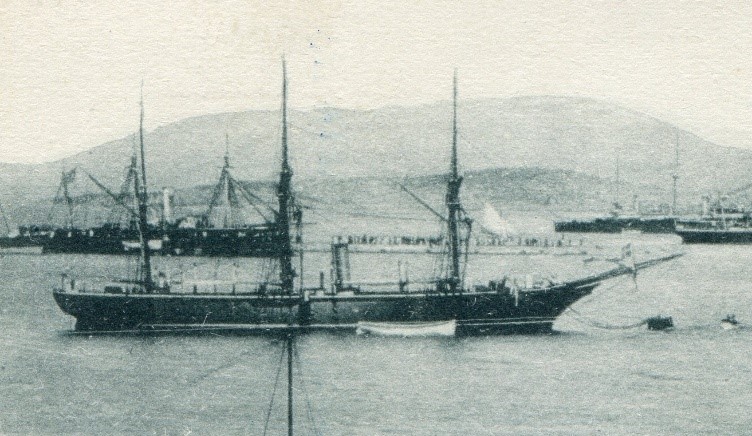
One of ‘the Four Rivers’ in the late 19th century
During the Greek-Turkish War of 1897, all four ships were active. On January 25, before the declaration of war, the PENIOS was part of a Greek squadron (Commander I. Damianos) deployed in order to prevent the transfer of Turkish aid to Crete and the resupply of its forces there. The PENIOS was loaded with supplies and towed two barges to supply the Fleet ships. The ALFIOS, under the command of Captain Pavlos Kountouriotis, accompanied the ships that landed at Kolymvari, near Chania on February 2, 1897 in support of the Christian population. Towards the end of the disembarkation, there was a commotion when the PENIOS was mistaken as an enemy ship. The Commander of the PENIOS issued an order to change the location of the landing, which no longer made any sense as the landing had already been completed. All four steamships remained on the coast of Crete despite pressure from the Allies to remove them. The PENIOS also hampered the sailing of a Turkish merchant ship from Souda. The Greek commanders, who had received an order saying “To oppose unjust violence with fair violence, even at the risk of sinking their vessels” were able to land supplies for the Cretans. When the Allied warships threatened to sink them, Kountouriotis did not hesitate to threaten a military uprising and man the only cannon on the ALFIOS. In the face of this determination, the Allies did not persist and the Greek ships completed their mission. On the 18th of April 1897 the Greek-Turkish war broke out and the Fleet rushed to cover operations on the coasts of Thessaly and Epirus. The EUROTAS fired at the Turkish strongholds at the entrance of the Gulf of Amvrakia with other ships of the Western Squadron and subsequently contributed to the blockade of the Epirus coasts by patrolling the region. The ALFIOS was assigned to the Eastern Squadron and on April 10, it fired on Turkish storage sites at Skala Leptokarya. The following day, it was realized that the damage caused was insufficient, and that was why members of the ALFIOS’ crew and those of torpedo boats No. 14 and No. 16 disembarked. However, the action was perceived by a Turkish guard who responded by opening fire, killing the mission leader from torpedo boat No. 16, Emmonius Antoniadis, along with a sailor of the same boat, Athan. Koutsogianopoulos and a sailor from the ALFIOS, I. Golemis. These three were the only casualties of the Navy during the 1897 war.
The Eastern Squadron included both the PENIOS and ACHELOOS and together with the ALFIOS, they were ordered to block the Thermaic Gulf in April 1897. In the course of these duties, the Turkish-flagged steamship, GEORGIOS was identified on April 30 by the PENIOS steamship (Commander I. Miaoulis) sailing near Tenedos (now the Turkish island of Bozcaada, close to the Dardanelles) and torpedo boat No. 14 (Lieutenant-Colonel Kanellopoulos). In the ensuing skirmish, it was revealed that the ship was carrying 100 Egyptian volunteers, weapons and ammunition and was thus seized and towed to Piraeus. The GEORGIOS, which was the first captured prize of the Fleet War after the initial liberation struggles, remained moored at Xaveri (in Piraeus) for several months before being incorporated into the Navy under the name of the CRETE.
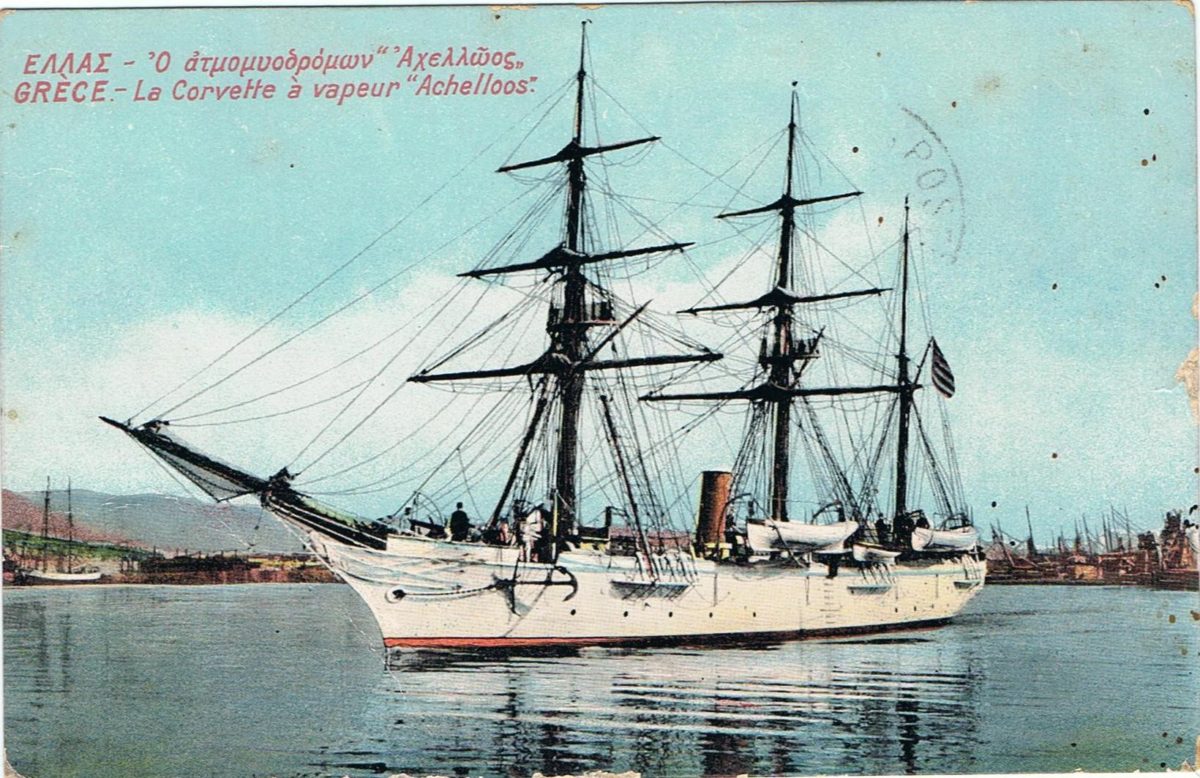
ACHELOOS after the adoption of white in ‘the four rivers’
The ALFIOS had a major breakthrough on May 6th when its crew discovered that the Austrian-Hungarian steamship MINERVA was carrying Turkish troops. With the assistance of the auxiliary ship CANARIS, it was seized, later to be returned to its owners. The ALFIOS was chosen in the winter of 1902 to patrol the coast of Thessaly. This was in response to information suggesting that the Bulgarian Commissariat would use boats in some kind of an invasion along the coast. However, no invasion ever took place – the information having come from the imagination of some paid informants.
In 1902, the four vessels had their masts removed, thereby losing their sailboat capability. The following year, the EUROTAS and ACHELOOS were used in wireless communications experiments conducted by French scientist, Edouard Branly. The two ships were fitted with Branly’s device, an electric motor, and a special 3-meter sailing boat to communicate with the ground-based wireless station that was then set up in Kastela, Piraeus. The experiments were successful, but it took several years for wireless communication to be extended to all Navy units. The steamships continued their educational duties, training cadets and even making trips abroad. For example, in the summer of 1908, the ACHELOOS and EUROTAS sailed to Messina, Sicily. In January 1909, the ALFIOS, PENIOS and AHELOOS were no longer considered suitable for training, but could be used in a role against smuggling. However, the ships continued their voyages, and the ACHELOOS carried out normal educational duties that summer and sailed to Taranto, Malta and Palermo.
At the outbreak of the First Balkan War in 1912, ‘the Rivers’ were designated as dispatch vessels. Their role was to carry messages when there was no safer or faster way. They were assigned to the Ionian Squadron under Captain I. Damianos, with the ALFIOS being the command vessel. They were deployed at Lefkada (an island off the Greek western seaboard), from where they controlled the entrance to the Amvrakikos Gulf in order to help block nearby Preveza and to prevent the vessels of its Turkish naval base from escaping. The Squadron consisted of torpedo boats ANTALYA and TOKAD, as well as the small coastguard vessels No.9 and No.10. Two days after the occupation of Preveza and the deliberate scuttling of the four Turkish vessels, the Squadron was disbanded and ‘the Four Rivers’ were sent to Corfu, where they supported the ongoing military campaign in Epirus. The ships patrolled from Parga (on the western Greek coast) to the shores of northern Albania with the aim of blocking Turkish forces there. When Nikolaos, King of Montenegro was informed about the presence of small warriors in the area of Skodra, he jokingly called them “My fleet”.
On 15/28 October 1912, one of the steamships located the English steamship NEVA, which was registered in Constantinople, sailing off the coast of Agii Saranda (opposite the island of Corfu). The boat was carrying fodder and thousands of petals which were thought to be destined for the Albanian army in Turkey. The NEVA was taken to Corfu, where the cargo was confiscated but the ship was released. On November 5, the EUROTAS, ACHELOOS and PENIOS, under the command of Deputy Commander K. Georgandas, supported the disembarkation of the Greek forces. After a brief clash, this led to the liberation of Himarea (in Albania). While Greek troops were in Himarea, Fleet ships provided general support, thereby enhancing the sense of security of the military units and the local population. On 9/22 November, the EUROTAS, ACHELOOS and PINIOS were sent on patrols in the Gulf of Avlona in the Northern Epirus to reconnoitre enemy forces so as to determine whether or not to execute a military operation. As part of the mission, a naval vessel landed on the island of Sazan (in Albania), which belonged to Greece under the Treaty of Ionian Islands of 1864. During its operations on the north coast, ALFIOS was hit by enemy fire on two occasions without significant damage. Then, on November 24, the 1st Infantry Regiment landed at Saint Saranda, with the action being supported by the EUROTAS, ACHELOOS and PENIOS. However, the advancement of the regiment towards Delvin was not completed in time, prompting the Greek forces to retreat to fortifications around Saint Saranda and eventually to return to the steamships from which they had disembarked. Under the protection of the Squadron, they sailed for Corfu and from there to Preveza. In the following days, the four boats transported non-Greeks from Buthrotum (in Albania) to Corfu. These people were fleeing the north in fear of retaliation. In February 1913 the three steamships – PENIOS was in the Navy dockyards for repairs after a landing – were attached to a Squadron which had sailed to Corfu under Captain Miaoulis. The Squadron’s mission was to protect the transshipments carried by the Serbian troops and thus the Squadron’s ships patrolled from the island of Sazan to Durrës, which lies to the north.
On March 12, the Turkish cruiser HAMIDIYE arrived in the area. It was spotted by the torpedo boat LOGCHI, which later lost contact with it. The HAMIDIYE managed to reach Saint John’s of Medusa [WHERE IS THIS?], where it successfully attacked Greek merchant ships. Three days later, HAMIDIYE crossed the Strait of Otranto, escaping south and according to Turkish records, it encountered the EUROTAS, but successfully escaped. This encounter is not confirmed by the Greek records. As to why the heavily armed HAMIDIYE would avoid the essentially defenceless EUROTAS remains unclear. Most probably, the HAMIDIYE had encountered the faster steamship LOGHI on March 12, and not the slow and unarmed EUROTAS.
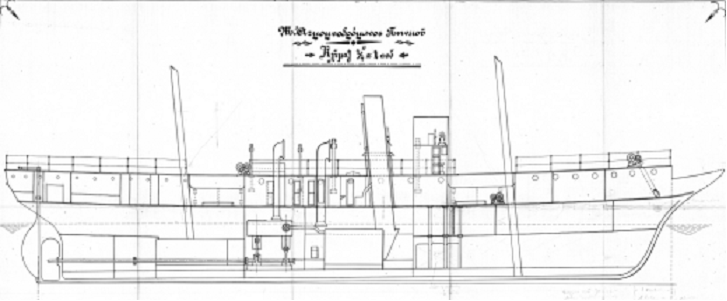
Shipbuilding project of PINIOS (K. Filippou)
In August 1913, the EUROTAS was sent to Maroneia (in northern Greece) to oversee the withdrawal of Greek forces from the Thracian coast, in accordance with the terms of the Bucharest Treaty. Following the intervention of the Allies in Greece, much of the Fleet spent September 1916 under French control. Among the ships that raised the French flag were the EUROTAS, ACHELOOS and ALFIOS, which were all seized at the Salamis Naval Port on Salamina island, south west of Piraeus. Despite the abnormal situation, the PINIOS returned after a month to continue the duties it had recently been assigned, namely the refueling of lighthouses and the maintenance of the ‘Pharos Network’ under the lighthouse service. Then the ALFIOS served as an “opportunity”, that is, as a personnel transfer vessel from Piraeus to the Salamis Naval Port. After the gradual return of the ships to the Greek Navy in 1917-1918, the EUROTAS did not return to active service. After this period, the AHELOOS was the headquarters of the Saronic Gulf Defense Command, remaining in the port of Piraeus until January 1922, when it was replaced by the battleship FARA. The ALFIOS was assigned in 1919 to the Navy’s Hydrographic Service for use in mapping and other services. In 1920-21, the ALFIOS undertook mapping the Asia Minor coasts under Greek rule. As part of its new duties, two Krupp 75/40 submachine guns, which were removed from the wreck of the Turkish warship FETH I-BULEND located in Thessaloniki, were fitted.
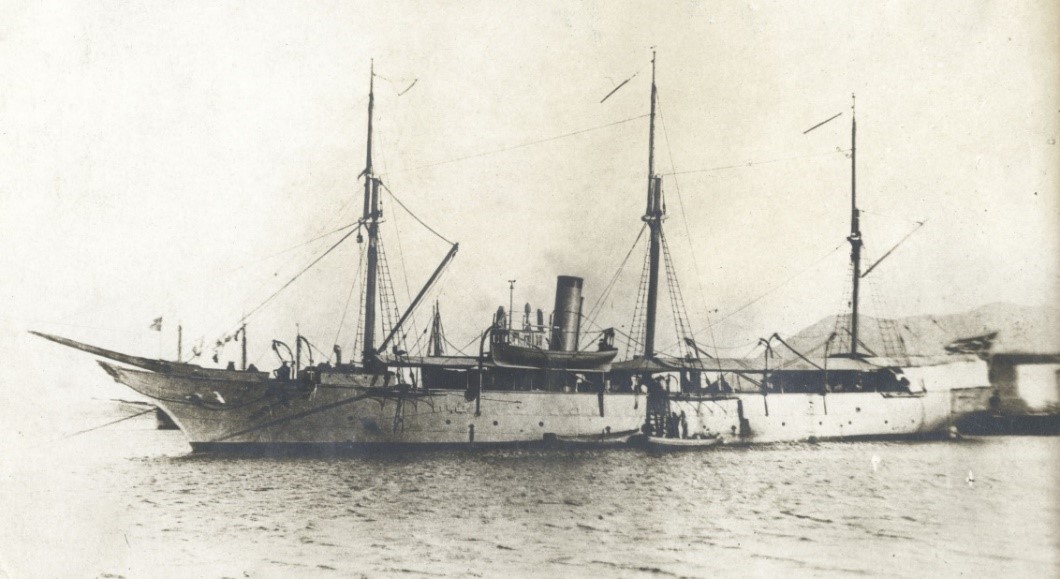
ALFEIOS as a hydrograph (Navy History Service)
In March 1921, the ALFIOS replaced the torpedo boat DAPHNE in patrols in the Adramyttiou Gulf (northwest Turkey) in order to prevent the descent of Czechs into the coastal areas. At the end of the Asia Minor Campaign, in September 1922, the ship helped evacuate part of the expeditionary corps to the island of Chios. With a military movement against the government and the King in progress, the ALFIOS fired its cannon against the steamer TINOS when it deviated from course. The TINOS was not captured and arrived in Chios in order to land dissident General, Nikolaos Plastiras, in violation of the orders that directed him to go to the island of Mytilene. After that, the ALFIOS went to the island of Samos where, on September 10th, it received the passengers who were on board the cruiser ELLI to transport them to Piraeus. After being used for some time as an “opportunity”, it was decided in 1925 to convert the ALFIOS into an oceanographer and in May of that year, it was renamed the NAUTILOS. The boat provided valuable services for a long time. During the first few years, it also doubled as a Marine Corps training vessel.

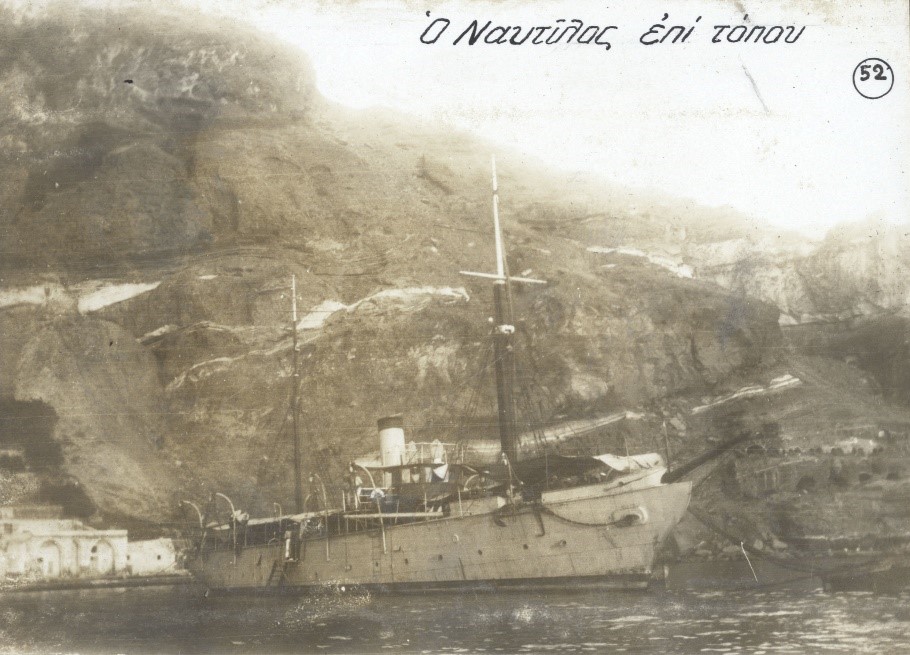
The Oceanographic Navy in Thira (Navy History Service)
By 1925, the ships had already completed forty years of service, so the ACHELOOS was decommissioned. In February 1926, it was announced that the EUROTAS and ALFIOS would be sold off in an auction by the Ministry of the Navy. The ACHELOOS was the first to be sold, in March 1927, to Pan. A. Sofian, who paid 225,000 drachmas. After removing various parts, he granted his ownership to I. Peppa as a pledge against a loan of 143,000 drachmas and the vessel was converted into a slip. In April 1934, it was renamed the AKTI, but it was scrapped in the same year.
The EUROTAS was sold in 1934 to Master Soph. Ioannou and converted into a sailing cargo vessel and registered in Spetses (in the Attica island group, near Athens). The ship was renamed the THEOLOGOS IOANNOU, rated at 290 gross tonnage and recorded as being built in 1931. These spurious details were later corrected. In 1938, it was transferred to Lavrio (on the Sounion Peninsular) and then to the Piraeus Sailing Register, where it was registered as an oil cargo sailing vessel. In January 1940, it was sold to A.E. I. F. Kostopoulos, based in Kalamata (in the southern Peloponnese) and renamed AGIOS SPIRIDON. In March 1941, it was sold again to A.N.E. Nagos (of Ar. Xylas). Soon, however, the ship fell into the hands of the Germans and was pressed into service. In October 1944, it was deliberately scuttled in Thessaloniki as the Germans were fleeing Greece. The shipwreck of AGIOS SPIRIDON was brought to the attention of Achilleas Chalkousi, the head of the Xylas family, who was looking for a means of transporting agricultural products to Egypt. It was recovered in April 1945 and repaired in Piraeus on the basis of plans drawn up by shipbuilder Alexander Philip. Upon completion of the work, it was reclassified as 290 tons and renamed the NAGOS. It soon started sailing in the eastern Mediterranean.
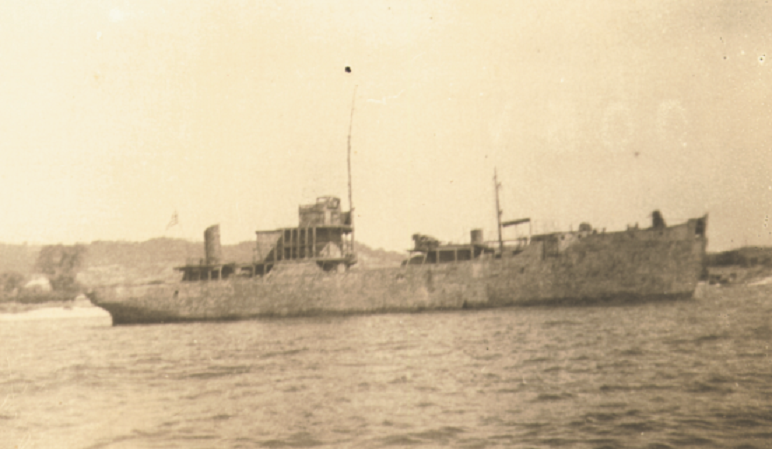
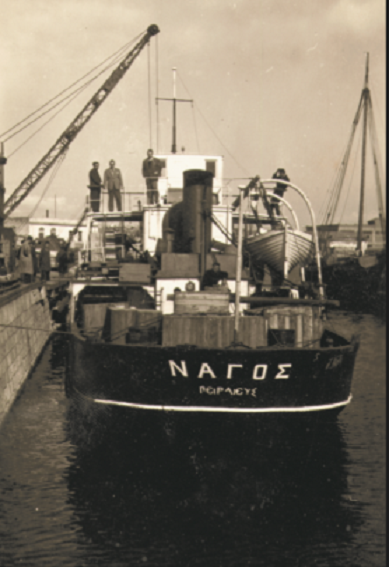
The elevated shipwreck of AGIOS SPIRIDON (left) and the motorship NAGOS (right) (Ach. Chalkousis collection by G. Foustanou)
On July 26 1951, the NAGOS was in the middle of a trip from Thessaloniki to Alexandria, with many stops on the way. It was sailing south of the island of Anafi in the Cyclades when water inflow and engine damage was reported, leaving the ship crippled. It sank two hours later, six miles west of Pachia (in the Dodecanese islands), after its crew had safely abandoned ship.
A similar fate befell the PENIOS. It was decommissioned in 1928 (or, according to other sources, in 1930) and sold in 1931 to coal miner, Nick. Panayiotopoulos. The engine, boilers, funnel, masts, anchors and the propellers were all removed. The remaining hulk was sold again in 1932 to P. Kokkinogouli and transformed into diesel-powered freighter, the KATINA KOKKINOGOULIS. In 1934, it was resold to the ‘Hellenic Society of Wines & Alcohol’ and renamed the EPAMINONDAS. The ship sank at Katakolos on the western coast of the Peloponnese in February 1941 due to a hull breach. The wreck was sold in 1948 to Ah. Katzani & Co. and recovered. Despite the deterioration caused by many years submerged, not to mention 60 years of service at sea, it was not considered beyond repair. The reconstruction work was carried out in 1949-50 based on the plans drawn up by Alexander Philip. After the completion, the ship was renamed the TRIS IERARCHE. It was re-rated at 266 tons GRT and its dimensions were recorded as 43.32 metres long, 7.64 metres in beam, with a 3.96 metre draft. It continued to operate as a ferry until January 13, 1959. On that day it was sailing from Piraeus with a crew of ten, headed for Porto Lagos in northern Greece, but the ship encountered adverse weather and was lost on the east coast.
The NAUTILOS was the last of ‘the Four Rivers’ which remained in the service of the Navy. Eventually, it was decommissioned in 1936 and converted into a barge the following year.
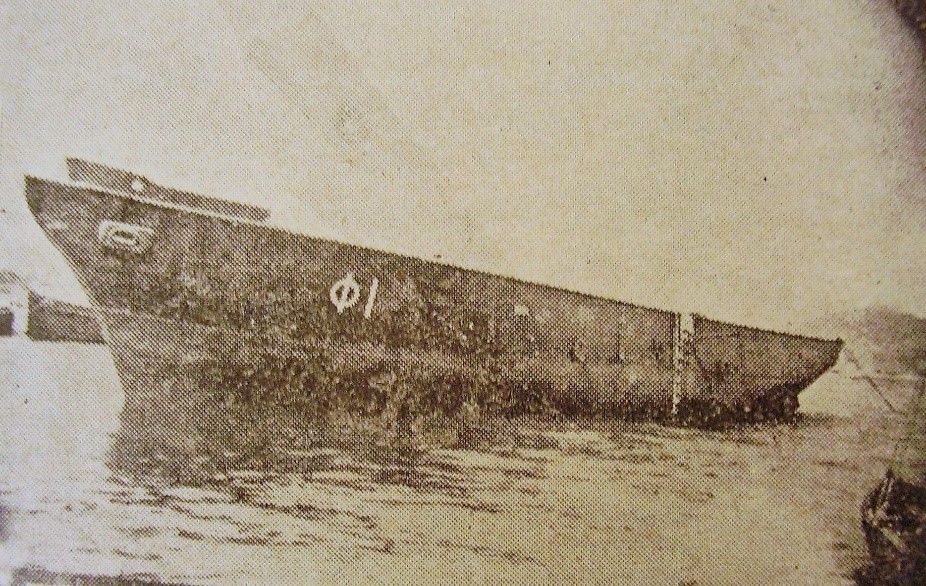
NAUTILOS after it became obsolete and converted into barge (Hellenic Navy)
The decommissioning of the NAUTILOS featured in a “Greek Navy” article which concluded that: “This is the ship which, as an old sailor who fought with the sea and fire, is now being prepared, with the full satisfaction of carrying out its duty, to accept the inevitable fate of all things. But it is an end so beautiful, crowned with laurels sprinkled with seawater, which will be accompanied by the sweet memories of a whole world of past and present that has lived, worked and performed on its present lifeless shell.”
What happened to NAUTILOS after its conversion into barge has not yet been established. An interesting theory which requires further investigation is the correlation between the NAUTILOS and the freighter POLYVIOS. The POLYVIOS was registered in Piraeus in 1948, but its origin was never recorded. However, it was registered as being 269 tons and 42.1 x 7.4 metres in dimension. The idea of it being associated with the NAUTILOS comes from the fact that Lloyd’s Register reports that the POLYVIOS was formerly called the ALFIOS. Research to date has not identified any other pre-war vessel named ALFIOS, other than the steamship ALFEIOS. Although the vessel had been known as the NAUTILOS since 1925, it is possible that a Lloyd’s inspector might have noticed an inscription of its original name on the ship. Moreover, the dimensions of the ALFIOS were very close to those of the POLYVIOS. However, Lloyd’s records the POLYVIOS as being constructed in 1935 on the island of Samos. This is erroneous as iron ships were never built on Samos. Most likely, Lloyd’s confused the wooden ship POLYVIOS, which was built in 1936 in Tagan on Samos, with the post-war POLYVIOS.
Although the correlation between the freighter and the POLYVIOS cannot be conclusively established, it should be mentioned that the NAUTILOS was sold in 1948 by E. Venardis to P. Krassakopoulos and again in 1952 to a Panamanian company, which renamed it the MARE NOSTRUM. In 1954, it was sold to Vinalmar S.A. of Geneva, transformed into a wine tanker and renamed the TINTO under a Costa Rican flag. In 1960, it was lengthened to 46.8 metres and the gross tonnage increased to 388. In 1967, it was renamed the TRANSVIN under the same ownership, but with a Panama flag. However, on the 21st November 1969, it disappeared while sailing from Heraklion (on the island of Crete) to France, apparently having sunk.
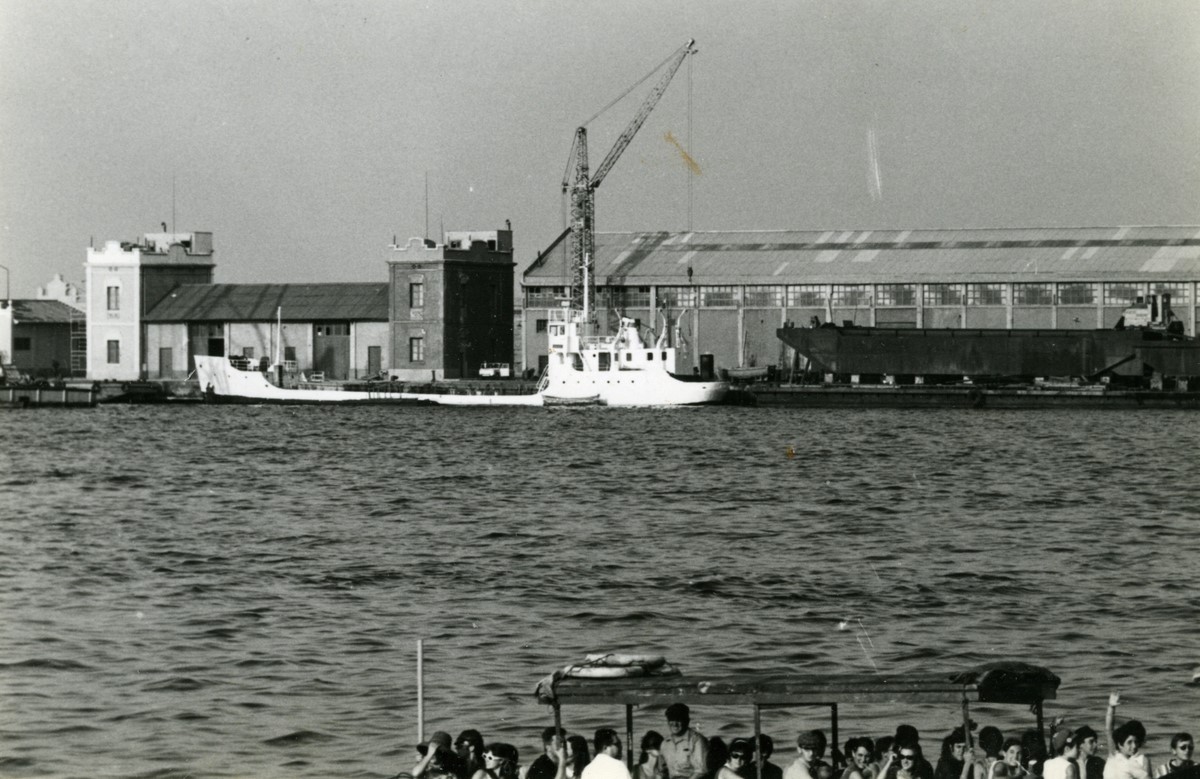
References
Milesis Stefanos, The Secret Experiment of Kastella, pireorama.blogspot.gr, 2012.
Dounis Christos, Shipwrecks in the Greek Seas – 1951-2000, Finatec SA, 2001.
Paizis-Paradelis K., Navy Ships 1829-1999, Asteria, 1999
Philippos Constantinou, Naval Ship Records (cd), 2008.
A dying boat, Hellenic Navy, October 1936.
“Script” (newspaper), History of the Naval War 1912 – 1913.
Piraeus Register
This article is a supplemented version of the article presented by Nautical Hellas Magazine on 4 & 5/2015.
[*] Ross J. Robertson is an Australian who has lived in Greece for the past thirty years. He has a BSc (Biology) and is an EFL teacher. He is the co-owner of two private English Language Schools and instructs students studying for Michigan and Cambridge University English Language examinations. He has written various English Language Teaching books for the Hellenic American Union (Greece), Longman-Pearson (UK) and Macmillan Education (UK). He published his debut novel (fiction/humour) entitled ‘Spiked! Read Responsibly’ in 2016. Moreover, he has written several spec screenplays and a number of newspaper articles, including an extensive series on the 75th anniversary of the WWII Liberation of Greece. A keen AOW and Nitrox diver, he is also a shipwreck and research enthusiast and has written features for UK Diver Magazine, US Diver and the Australian newspaper, Neos Kosmos. Ross continues to combine his expertise in English with his love of storytelling and local WWII history to produce exciting materials.
